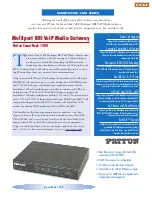
The duration value is set in seconds and can be set from 1 to 3,600 seconds (1 hour). This
duration value indicates how long the alarm condition must last before an alarm is declared.
Low bit-error rates (10
7
through 10
9
) are restricted to longer durations because it takes more
than one second to detect an alarm condition above10
6
. Higher bit-error rates are restricted
to shorter durations because the MMI error counter fills at 65,000 errors.
If the
Set Clearing (S C)
"Enable Self Clearing" option is set, the alarm indications (LEDs
and external alarm contacts) is automatically cleared after the specified period, or duration,
expires. Otherwise, the alarm continues until the command
Clear Alarm (C A)
is
entered.
When an alarm is cleared, all activity caused by the alarm indications is cleared:
• the external alarm hardware is deactivated (the contact normally open is reopened)
• the LED goes out
• an entry is made in the alarm log of the date and time the alarm was cleared
• carrier-fail line supervision ceases (for alarm level 2 only)
If self-clearing alarm indications are disabled, carrier-fail line supervision terminates when the
alarm condition has ceased, but the external alarm contact and faceplate LED remain active
until the alarm is cleared.
A heavy bit-error rate can cause 200 bit errors to occur much more quickly than 100 seconds.
This causes the alarm to be declared sooner.
An alarm condition is not automatically cleared until the system no longer detects the respective
bit error threshold during the corresponding duration period.
For example, if AL1 threshold of 6 (representing 10-6) is specified, and a duration period of
100 seconds is specified, an alarm is activated if more than 200 bit errors occur in any 100
second period. As soon as the alarm is activated, the bit counter is reset to 0. If the next 100
seconds pass, and less than 200 bit errors are detected, then the alarm clears after the alarm's
duration period. However, if more than 200 bit errors are detected in the next 100 seconds,
the alarm condition continues for the designated time period.
The alarm finally clears when the alarm condition is no longer detected for the designated
period, either by self-clearing (if this function is enabled), or when the
Clear Alarm (C A)
command is entered.
In addition to bit errors, the Set Alarm function sets parameters for detecting frame-slip errors
by establishing a threshold necessary to activate an alarm. If the threshold value is exceeded,
a level 2 alarm is activated. The frame slip threshold can be specified from 1 to 255 frame slips
per time period. The duration time period can be specified from 1 to 24 hours.
When entering the
Set Alarm (S A)
command, the MMI scrolls through the previously
described series of alarm options. These options are displayed along with their current value,
at which point a new value can be entered or enter
<CR>
on page 230 outlines the options available in the
Set Alarm (S A)
function.
Man-Machine E1 maintenance interface software
Circuit Card Reference
July 2011 229
Summary of Contents for 1000 Series
Page 1: ...Circuit Card Reference Nortel Communication Server 1000 7 0 NN43001 311 04 04 July 2011 ...
Page 20: ...20 Circuit Card Reference July 2011 ...
Page 30: ...Introduction 30 Circuit Card Reference July 2011 Comments infodev avaya com ...
Page 116: ...Option settings 116 Circuit Card Reference July 2011 Comments infodev avaya com ...
Page 143: ...Figure 25 CP PIV card front Physical description Circuit Card Reference July 2011 143 ...
Page 148: ...NT4N39AA CP Pentium IV Card 148 Circuit Card Reference July 2011 Comments infodev avaya com ...
Page 287: ...Figure 86 Clock Controller Option 3 Operation Circuit Card Reference July 2011 287 ...
Page 302: ...NT5K21 XMFC MFE card 302 Circuit Card Reference July 2011 Comments infodev avaya com ...
Page 346: ...NT6D80 MSDL card 346 Circuit Card Reference July 2011 Comments infodev avaya com ...
Page 353: ...Figure 96 NTDK16 DLC Functional description Circuit Card Reference July 2011 353 ...
Page 461: ...Figure 147 Paging trunk operation Applications Circuit Card Reference July 2011 461 ...
Page 462: ...NT8D15 E and M Trunk card 462 Circuit Card Reference July 2011 Comments infodev avaya com ...
Page 500: ...NTAK09 1 5 Mb DTI PRI card 500 Circuit Card Reference July 2011 Comments infodev avaya com ...
Page 512: ...NTAK10 2 0 Mb DTI card 512 Circuit Card Reference July 2011 Comments infodev avaya com ...
Page 534: ...NTAK79 2 0 Mb PRI card 534 Circuit Card Reference July 2011 Comments infodev avaya com ...
Page 550: ...NTBK22 MISP card 550 Circuit Card Reference July 2011 Comments infodev avaya com ...
Page 560: ...NTBK50 2 0 Mb PRI card 560 Circuit Card Reference July 2011 Comments infodev avaya com ...
Page 595: ...Figure 165 MGC block diagram Introduction Circuit Card Reference July 2011 595 ...
Page 662: ...NTRB21 DTI PRI DCH TMDI card 662 Circuit Card Reference July 2011 Comments infodev avaya com ...
Page 668: ...NTVQ01xx Media Card 668 Circuit Card Reference July 2011 Comments infodev avaya com ...
Page 700: ......
















































